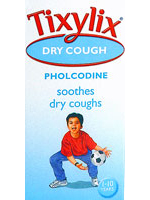 Ingredients
Ingredients- Pholcodine
- Citric acid
- Glycerol
- Potassium acesulfame
- Maltitol
- Hydroxyethyl cellulose
- Sodium benzoate
Published June 2009
This is designed to stop the type of unproductive cough which is like an irritating tickle at the back of the throat. Tixylix is the one which parents give to children; there are similar products for adults although these are less well known.
Ingredients
Pholcodine (aka morpholinylethylmorphine) is the active ingredient. It is manufactured from morphine by adding a morpholine group to the molecule. This suppresses both its painkilling and euphoric effects and it targets the coughing reflex. Pholcodine is a controlled substance in the US because, being an opiate, it could be habit forming. It is alkaline and has a bitter taste hence the need to add the artificial sweetener potassium acesulfame.
Citric acid (aka 2-hydroxypropane-1,2,3-tricarboxylic acid) has a fruity acid tang and is naturally present in lemons and limes. It is manufactured industrially by the action of the Aspergillus niger fungus on sugar. Citric acid is added to laundry detergents to counteract hard water. It is used in the manufacture of the explosive HMTD (hexamethylene triperoxide diamine) and consequently bulk sales are closely monitored.
Glycerol (aka propane-1,2,3-triol) dissolves the pholcodine which is not very soluble in water. It is a by-product of biodiesel manufacture and there is a world glut of glycerol which is why the UK government's 'Glycerol Challenge' is trying to find other uses for it. It is added to foods and has a sweet taste, and while it has about the same calorie content as sugar it does not cause dental caries.
Potassium acesulfame (aka potassium 6-methyl-2,2-dioxo-oxathiazine-4-one 2,2-dioxide) is an artificial sweetening agent which is soluble in glycerol and unaffected by acids and heat and is ideal for products with a long shelf-life.
Maltitol also sweetens the linctus slightly and it too does not cause tooth decay. More importantly it has laxative properties - opiates like pholcodine are constipating - and in some countries products containing maltitol must carry a warning to this effect.
Hydroxyethyl cellulose is a thickening agent which also acts as a laxative. It is manufactured on a large scale from cellulose by reacting it with ethylene oxide. Hydroxyethyl cellulose has hundreds of uses and is even employed as a thickening agent in foods like sauces. Mostly it is used to manufacture wall boarding, to thicken latex paints to make them non-drip, to make paper glossy, and for wallpaper paste. It is even used in suppositories.
Sodium benzoate is there as a preservative and under acid conditions it is an effective antibacterial and antifungal agent. It is an ideal preservative for carbonated drinks but it has been accused of causing hyperactivity in children, although the claims have never been substantiated, and indeed sodium benzoate is present naturally in certain fruits such as cranberries and plums. Blended with potassium perchlorate, it provides a whistling sound in fireworks when the mixture is ignited.